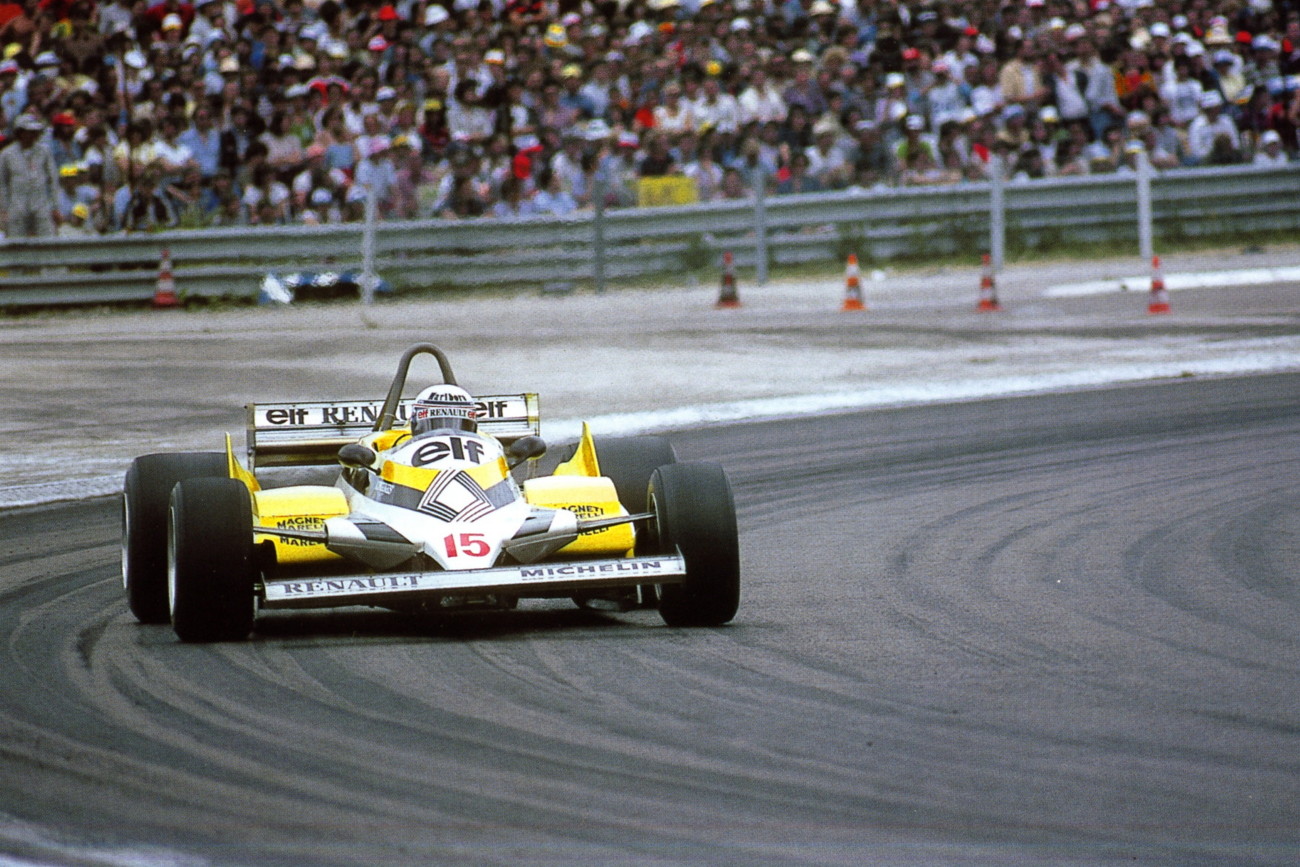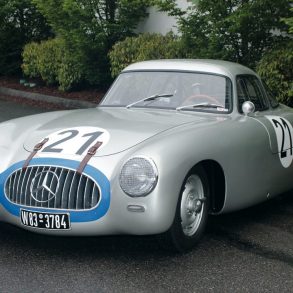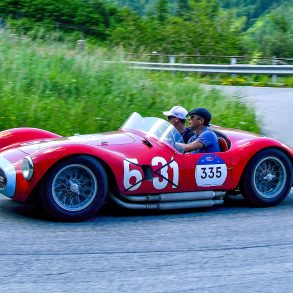Motor Racing History – The Monsters F1 Turbo Engines
The Turbo Years
The war between FISA and FOCA continued into 1981 causing the postponement of the Argentine Grand Prix. Bernie Ecclestone threatened to run its own World Professional Championship but luckily an agreement was struck at a summit meeting in Maranello which would come to be known as the Concorde agreement.
In 1966, when the formula was changed allowing for 3 liter engines a provision was made for 1.5 liter supercharged engines. With no takers amongst the current engine suppliers and the tremendous success of the Ford-Cosworth it was left to an outsider, yet one with a history that traced back to the first Grand Prix to show a third way. Renault had been trying to win Le Mans with a turbo-charged engine but was suffering from cracked pistons. Bernard Dudot was sent to Garrett AiResearch to study the fine art of turbo-charging. In 1979 the Renault turbocharged engine found its way into a Grand Prix car. They were soon joined by BMW and the turbo era was dawning. It was thought by some that turbocharged engines would allow large manufacturers to leapfrog the smaller British teams and their acknowledged leadership in chassis design.
By 1981 Ferrari was now firmly in the turbo camp but even the talents of Gilles Villeneuve couldn’t carry the ill-handling car to the championship. McLaren was now under the control of Ron Dennis and with John Watson driving a John Barnard designed McLaren MP4 it became the first carbon-fibre chassis car to win a championship race at the British Grand Prix. The title came down to the final race in Las Vegas and Piquet with a fifth place finish secured enough points to become World Champion. Turbo powered cars continued to make progress and when the year was over they had won seven of the 16 races on that years calendar.
Rules changes for 1982 banning the use of movable skirts forced teams to reduce ground clearances to around 25mm in conjunction with an almost total lack of suspension movement. The drivers were now experiencing cornering forces up to 4gs at some circuits. Double World Champion Niki Lauda was lured from retirement by a barrel full of Marlboro cigarette money to join John Watson at McLaren. Alan Jones went the opposite direction and quit Formula 1 opening a seat at Williams for Finn Keke Rosberg. The third rival for the title of the previous year, Carlos Reutemann also retired, this time after the first two races.
The turbos of Ferrari, Renault and now Brabham dominated the opening race at Kyalami with Prost taking the flag. The British teams continued to fight what would become a losing battle against the turbos. Brabham, having access to both turbo and Cosworth engines tried to straddle the middle. Piquet in a Brabham took Brazil but only after temporarily reverting to a normally-aspirated engine. The turbo cars had a clear advantage on the faster circuits but their continued turbo lag proved a handicap on circuits with a lot of corners. Only after Spa was it dragged firmly into the turbo camp by its erstwhile engine supplier BMW.

Almost as an afterthought the race was won by John Watson for McLaren. At Monaco it rained but Riccardo Patrese was able to stay on the track and score his first victory. Watson and Piquet took the next two races, Detroit and Canada, respectively. By the German Grand Prix the title race was between Pironi and Watson only to have the Ferrari driver suffer career ending injuries during practice. The Swiss Grand Prix which was held in Dijon, France was won by Rosberg who now found himself in the championship’s lead. The season ended at the lamentable Las Vegas, US Grand Prix – West and though the race was won by Michele Alboreto in a Tyrrell the title went to Keke Rosberg. The battle between turbo-charged and normally aspirated cars were now dead even at 8 victories apiece.
A turbo-charged car had yet to take its driver to the World Championship. That was to change in 1983. Two new manufacturers introduced turbo-charged engines – Honda and TAG-Porsche. 1983 also saw the effective banning of ground effects with the requirement for flat bottoms. The first half of the season saw Ford-powered victories at Long Beach, Monaco and Detroit before the turbos took over for good. The 1982 season had been a development season for Brabham and new engine supplier BMW, but when the car came right Nelson Piquet was the man to bring it home winning two of the last three races and claiming his second World Championship. The eighties now had their second double World Champion but there seemed to be something missing that year.

Duel of Champions
It was 1984 and turbo-charged engines were soon to be used by all of the teams save Tyrrell which soldiered on with the normally-aspirated Cosworth-Ford. Fuel consumption was restricted to 220 liters with refueling stops no longer allowed. Mandated by a desire to reduce overall speeds these rules had the negative impact of turning many of the races into “economy runs”. Radial tires became standard equipment for both wet and dry tires. TAG commissioned German sports car manufacturer Porsche to design and build a turbo engine for McLaren. Porsche had extensive experience with similar economy rules due to its participation in endurance racing and this translated in superior fuel economy. The engine Porsche developed was a 90 degrees V6. For aerodynamic reasons, the Porsche-typical flat engine was out of the question for being too wide.

Feeling snubbed by McLaren and Williams after what he felt were successful tests his unsatisfactory 2nd place at Monaco did little to change his perception that the racing establishment were arrayed against him. This attitude would not change away easily. The next two races oddly enough were the twin US Grands Prix at Detroit and Dallas. Nelson Piquet scored a victory in Detroit but the race in Dallas proved a near fiasco when the newly laid asphalt surface melted under the fierce sun and started to come apart. Despite the driver’s strong misgivings the race was held under the orders of Bernie Ecclestone. The race actually proved quite thrilling due to a rousing duel between the Englishmen Mansell and the Finn Keke Rosberg. The race was decided when Mansell had to visit the pits for new tires. Mansell’s race ended in a heap literally when he collapsed while trying to push his Lotus over the line for 5th place. Whether feigned or not it proved great theater.

For 1985 new man Ayrton Senna joined Elio de Angelis in the Lotus team replacing Mansell who moved to Williams. Alboreto lifted Ferrari’s spirits after a single win season in 1984 with a pole position in the opening race in Brazil only to collide with Mansell’s Williams in the first corner. Luckily the Italian was able to continue and even lead up to lap 18. A bad gear change allowed Prost into the lead where he would remain. The Portuguese Grand Prix now the second race on the calendar was run in a complete downpour. The race saw the brilliance of Senna displayed for all to see. Starting from pole he was 30 seconds in the lead after the same amount of laps. By the end he led the only other car on the same lap by 1 minute 32 seconds a new star had arrived.
Senna continued his charge at Imola challenged by Prost in a duel that would continue for the rest of their careers. Senna was just able to hold off Prost but in doing so ran out of fuel two laps from the end giving the Frenchman the victory only to be disqualified in favor of Senna’s teammate de Angelis. The Belgian Grand Prix was a complete disaster when the track broke up during qualifying forces the race to be abandoned in disgrace. Saturday morning drivers stopped practice after 15 minutes, saying the track was undrivable. Lauda described it as ”driving on snow.”
For the Canadian Grand Prix the first four places were held by Lotus and Ferrari. While strong qualifying performances were beginning to be expected from Senna it must be pointed that his teammate de Angelis was rarely embarrassed by the Brazilian and more often then not showed a fair amount of speed in his own right. The race itself belonged to the Ferrari team with a 1-2 lead by Alboreto. In Detroit it was Rosberg’s turn to shine while Piquet showed all that he was still a force to reckon with by taking the French Grand Prix. With Rosberg, Lauda, Mansell, Piquet, Prost, Alboreto and Senna the F1 world had seven driver’s worthy of being World Champion.

Besides the retirement of Lauda the end of the season also brought about the withdrawal of the full Renault factory team. Major financial problems emerged at Renault and the company could no longer justify the large expenses needed to maintain the racing team’s competitiveness. CEO Georges Besse pared down the company’s involvement in F1 from full-fledged racing team to engine supplier Having started the turbo era in 1977 the French team was unsuccessful in winning either championship.

As regards to drivers Keke Rosberg would leave Williams to join McLaren and take John Watson seat. Nelson Piquet would take the now vacant Williams-Honda seat. Alfa Romeo found themselves without an engine. The Toleman team would now be known as Benetton with Gerhard Berger and Teo Fabi as their drivers and now powered by BMW engines. The Brazilian sensation, Ayrton Senna was still at Lotus and his co-driver would be Johnny Dumfries (Earl of Dumfries) after Senna blocked their original choice, Derek Warwick. Renault which would no longer compete as a team would still provide engines for the Lotus, Tyrell and Ligier team. Tyrrell would add pay driver Phillippe Streiff to partner alongside Martin Brundle. Carl Haas’s Lola-Force team would now be known as Beatrice.

With their founder in a London Hospital the Williams team still had to make their way to Brazil, the first race on the calendar. Ayrton Senna started from pole but was soon being pressured by the Williams of Nigel Mansell and Nelson Piquet. While Mansell had a spin after contact with Senna, Piquet would take the win by 34 second over countryman Senna driving a Lotus 98T. A minute behind Piquet, in third place was French driver Jacques Laffite driving a Ligier JS27. A little cheer would return to the Williams team.
The next race would bring the teams to Jerez in Spain after a five year absence. This race featured a three car battle for over the last half of the race between Senna, Mansell and Prost. Sensing an opportunity Mansell pitted for fresh tyres making up over 19 seconds in the final 10 laps on his fresh rubber but he was not able to pass a defensive Senna who took checkered flag by 0.014 seconds it was one of the closest finishes in Formula One history. The third round of the year’s World Championship was held at Imola, the San Marino Grand Prix. Alain Prost dominated the race after Senna and Nigel Mansell both retired early. The only bit of excitement came when Prost almost ran out of fuel, three corners from the checkered flag. Prost would win again from Pole at Monaco.

It seemed that going into the tail end of the season the only question left was which of the Williams teammates would become the new World Champion. Within the team Mansell and Piquet were bitter rivals with Piquet believing he had been promised number one status in the team, which he hadn’t received. It had been sixteen years since Formula 1 had been back to Mexico. Ayrton Senna claimed his eighth pole of the season with Piquet joining him on the front row. Gerhard Berger joined Mansell on the second with both drivers feeling out of sorts, Mansell suffering the “revenge” of Montezuma. Alain Prost was directly behind Berger on the third row. When the flag dropped Senna held his lead as far as the first corner before locking up, running wide, and letting Piquet through into the lead. Mansell made a horrible start when he was unable to find first gear and completed the first lap in 18th place! By eleventh lap Mansell had clawed his way up to ninth only to pit with blistering tires. One by one the front-running drivers on Goodyear tyres were forced to make stops.

The race in Australia was decided by tires. On the 34th lap a puncture forced Prost, then second behind Rosberg, into the pits for a 17-second tyre change. When the Goodyear technicians saw the state of Prost’s tyres they decided the cars would be able to get through the 82-lap race without a change, and advised the teams accordingly. This faithful decision would doom Mansell’s chances when his tire blew on the 63rd lap damaging his suspension. Piquet, who was leading the race, was called in to change his tyres for safety reasons, leaving the lead to Prost. Piquet closed to within four seconds of the leader because Prost had to slow to conserve fuel but could get no closer. The victory gave Prost the World Championship by two points over Mansell.
Honda Power

Previous World Champions Alan Jones and Keke Rosberg had both retired from F1, Jones after a brief comeback attempt while defending World Champion Alain Prost was joined at McLaren by Swedish driver Stefan Johansson, replacing the retired Keke Rosberg. John Barnard who quit the team in August of last year was replaced by American engineer Steve Nichols. Under his leadership and Barnard’s design the team produced the first all-new chassis design for McLaren International since the successful MP4/2 series of cars that debuted at the start of the 1984 season.
Michele Albereto was partnered with Austrian Gehard Berger at Ferrari. Former ATS and RAM designer, Austrian Gustav Brunner, designed the all new Ferrari F1/87 with assistance from the team’s new Technical Director, John Barnard, who had joined Ferrari after six highly successful years at McLaren. The car featured a six-speed gearbox and an all-new 90° 1.5 litre turbocharged V6 engine which replaced the old 120° V6 Tipo 032 which had been in use since 1981.
Williams would continue to supply Honda powered cars for bitter rivals Nigel Mansell and Nelson Piquet with replacement driver Ricardo Patrese filling in for Mansell at the Australian Grand Prix while he recuperated from a back injury suffered in Japan during qualifying. Their car the FW11B was only a minor upgrade over last years model, at least until their “reactive” suspension which proved lighter, less complicated and drew much less power than Lotus’ version of the suspension, was added later in the year. After winning nine races the previous season but coming up short in the World Championship the team’s main focus was on improving reliability.






The 1988 season saw many changes with Tag-Porsche and BMW having officially withdrawn from Formula One at the end of the 1987 season. New restrictions were placed on the turbos for their last season of eligibility but the entire grid was buzzing with the realization that the news that last year’s Constructors Champion were losing their engines had actually become a reality and Honda would instead be supplying McLaren but also that their drivers for the upcoming season were to be Alain Prost and Ayrton Senna. The nightmare for the other teams would begin. With the two best drivers and the best engine at their backs, it seemed that the only question left was which one would take the title.The FIA declared in a new regulation for safety purposes that the cars pedals needed to be behind the line of the front axle to protect the drivers legs and feet in the event of an accident. Unfortunately to the drivers discomfort the regulation was met by many teams simply shortening the cockpit.

Williams could only manage 8th and 9th place in the Championship, the latter position belonging to Mansell whose best results were two seconds havening been done in by twelve retirements and two races where he failed to score any points. Mansell’s first six races were marred by five engine failures and a collision.
Without real competition McLaren was able to dominate the season with 15 of 16 wins. Senna would take eight wins to Prost’s seven allowing him to claim his first World Championship, something he seemed destined to do ever since he first hit the track. McLaren also won the Constructors’ Championship scoring 199 points, triple the score of the second place Ferrari team who were still able to score an emotional win in Italy, after the death of their founder Enzo Ferrari the month prior.
He once dreamed of becoming an opera star or a sportswriter, but in automobile racing he had found his calling. The greatest drivers in the world raced his cars knowing that they would always play second fiddle to his red machines. Froilan Gonzalez, who would win Ferrari’s first Formula One race called Ferrari the “sacred monster” of the motoring world. Unlike others who raced to sell cars Ferrari sold cars to race. He built sports cars to pay for his racing and to take part in what he once called his terrible joys.















